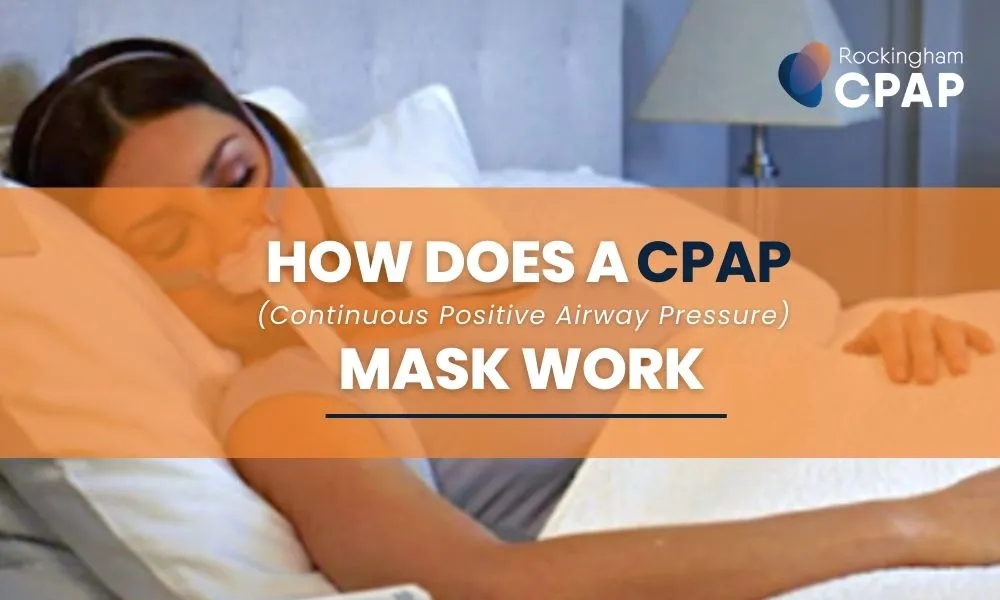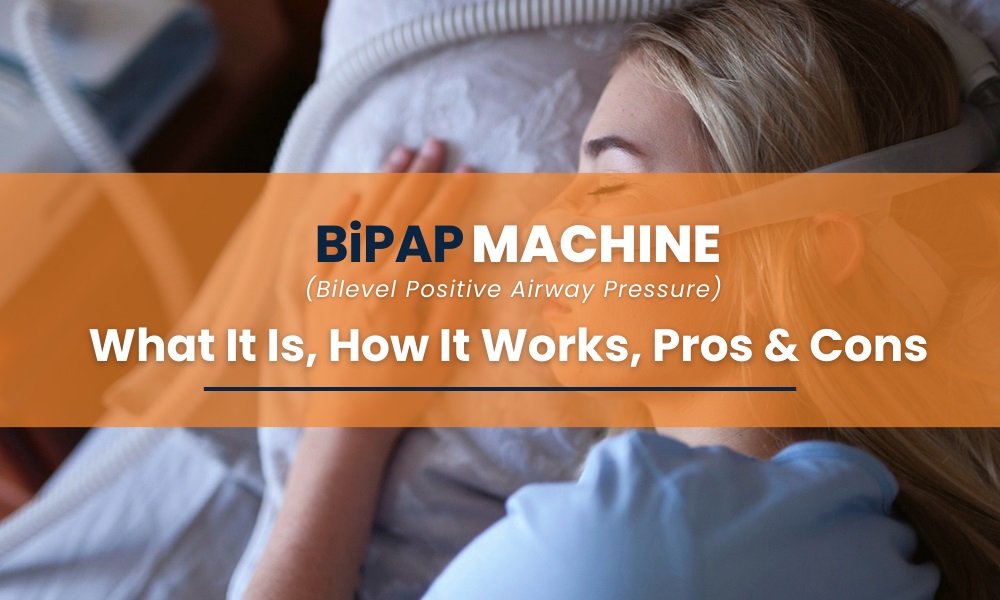
Before we explore how the mask of a CPAP machine works, let’s first consider the other main components of a CPAP System.
The CPAP Machine:
The Continuous Positive Airway Pressure (CPAP) machine is a pivotal element in treating sleep apnea. This medical device ingeniously provides a steady airflow, preventing the frequent breathing interruptions caused by sleep apnea. It’s designed to offer a customised pressure setting, tailored to each individual’s therapeutic needs.
The CPAP Hose:
The CPAP hose, a flexible and durable conduit, plays an essential role in connecting the CPAP machine to the mask. It must maintain the integrity of the airflow, ensuring that the prescribed pressure is consistently delivered without any loss. The hose’s design is key for maintaining flexibility and durability, allowing for comfortable movement during sleep.
With a clear understanding of the other two components, let’s now look into the CPAP Mask as a Crucial Component.
The CPAP mask is where the therapy becomes personal. It’s the point of contact between the machine and the user, and its importance cannot be overstated. The mask must fit perfectly to ensure comfort and prevent air leakage, which can compromise the effectiveness of the therapy.
The Role of the CPAP Mask
In CPAP therapy, the mask is the final and perhaps most critical element. It ensures that the pressurised air produced by the CPAP machine is delivered effectively and comfortably to the user’s airways. The mask’s role is to create a seal over the nose and/or mouth, maintaining the pressure needed to keep airways open.
Seal and Fit – Ensuring a Secure Connection:
A proper seal is fundamental. If a mask does not fit correctly or is uncomfortable, it can lead to air leaks or discomfort, disrupting sleep and diminishing the effectiveness of the therapy. The design of the mask is focused on creating a balance between a tight seal and user comfort.
Types of CPAP Masks:
Nasal Masks
• Design: Nasal masks cover the nose from the bridge to the upper lip area. They are designed to deliver pressurized air directly into the nasal passages.
• Fit: They typically have a silicone or gel cushion to improve comfort and create a seal. Many models include a forehead support to ensure stability.
• Who They Benefit: Ideal for patients who breathe through their noses during sleep. Good for patients who move around a lot in their sleep due to their secure fit.
• Considerations: They may not be suitable for patients who suffer from frequent nasal congestion or have had nasal surgery.
Full-Face Masks
• Design: Full-face masks cover both the nose and mouth. They are larger than nasal masks and have a more extensive sealing area.
• Fit: They also come with a cushioned seal and often have additional support at the forehead. Some feature a clear field of vision, which can be preferable for patients who like to read or watch TV before sleeping.
• Who They Benefit: Beneficial for mouth breathers or those with frequent nasal congestion, or for patients with higher pressure settings, which can be uncomfortable with smaller masks.
• Considerations: Because they cover more of the face, they can be more prone to leaks and might be uncomfortable for claustrophobic patients.
Nasal Pillow Masks
• Design: Nasal pillow masks are the smallest type of CPAP masks and have two soft silicone pillow cushions that insert into the nostrils.
• Fit: They are secured with minimal headgear and are less intrusive than other types of masks. They often offer a good field of vision.
• Who They Benefit: Ideal for active sleepers due to their minimalistic design and for patients who feel claustrophobic in larger masks. Also suitable for patients with facial hair.
• Considerations: They might not be suitable for higher-pressure settings as the air is delivered directly into the nostrils, which can be uncomfortable.
Hybrid Masks
Design: Hybrid masks combine elements of both full-face masks and nasal pillow masks. They cover the mouth and provide nasal pillows that insert into the nostrils.
Fit: This design helps to reduce the overall size of the mask and provides a stable seal around the mouth while minimizing facial contact.
Who They Benefit: Suitable for those who require a full-face mask but want more freedom and a clearer field of vision.
Considerations: Hybrid masks can be complicated to fit properly due to their unique design.
Oral Masks
• Design: Oral masks only cover the mouth and are used with a separate nasal interface like nasal pillows.
• Fit: They are secured by straps around the head and are used primarily by mouth breathers who cannot tolerate full-face masks.
• Who They Benefit: Good for users who breathe through their mouths but do not like the size or feel of a full-face mask.
• Considerations: Users must ensure that their nasal passages remain open throughout the night, which can be a challenge for those with sinus issues.
Total Face Masks
• Design: Total face masks cover the entire face, including the eyes. They are much larger than other mask types and provide an alternative for users who cannot find a comfortable fit with other masks.
• Fit: They create a seal around the outer edge of the face and are generally used as a last resort for users with highly specific needs.
• Who They Benefit: Beneficial for patients with facial irregularities or who require a very high CPAP pressure.
• Considerations: They can be more prone to leaks and are often less comfortable due to their size.
How CPAP Masks Deliver Continuous Positive Airway Pressure
The core function of the CPAP machine is to generate air at a specific, prescribed pressure. This pressure is calibrated to prevent the collapse of the airway, which is the primary issue in obstructive sleep apnea.
The pressurised air is then smoothly transmitted through the CPAP hose. This component is crucial for maintaining the airflow’s consistency and temperature, ensuring comfort and effectiveness.
Finally, the mask plays its vital role in delivering the air to the user’s airways. This step is crucial; the mask must distribute the air evenly, preventing discomfort and ensuring that the therapy is both effective and tolerable.
Types of CPAP Mask Seals
The effectiveness of a CPAP mask largely hinges on its ability to create a consistent and reliable seal against the user’s face. This seal is crucial as it prevents air leaks, which can reduce the efficacy of the therapy. There are various sealing mechanisms employed by CPAP masks to achieve this:
- Soft Silicone Cushions: This material is preferred for its ability to adapt to various face shapes while providing a comfortable experience.
- Gel Cushions: Incorporating a gel-filled cushion for a more personalised fit, moulding to the user’s facial features, providing a comfortable seal.
- Foam Cushions: Used alone or in combination with silicone, to create a seal. It feels softer against the skin and can fill in more irregularities in the face structure.
- Inflatable Cushions: Less common but offers an adjustable seal. Inflating the cushion achieves a tighter seal without increasing the strap tension, which can be more comfortable for some.
- Dual-Wall Cushions: An inner and outer cushion that work together providing a more secure and softer seal. This design helps distribute the pressure more evenly, reducing the likelihood of pressure sores.
- Memory Foam: A recent innovation in mask seal technology. It provides a soft and adaptive seal that responds to the warmth and pressure of the face, ensuring a snug fit.
Nasal Seals, Full-Face Seals, and Nasal Pillow Seals:
Each type of CPAP mask employs a different approach to sealing, based on the area of the face it covers:
- Nasal Seals: These seals only cover the nose and must contour to the varied shapes of the nasal bridge and nostrils. They generally use silicone or gel cushions and must balance the need for a tight seal with the comfort necessary for a good night’s sleep.
- Full-Face Seals: Full-face seals are larger and must provide a secure seal over both the nose and mouth. This is more challenging because the mask must accommodate for a wider range of movement (such as jaw opening) without breaking the seal. They often use a combination of silicone and foam to ensure both comfort and stability.
- Nasal Pillow Seals: Nasal pillow masks use small, soft pillows that insert into the nostrils. They seal directly at the entrance to the nostrils and rely on a snug fit that forms a seal upon insertion.
Importance of a Proper Seal for Effective Therapy:
The seal of a CPAP mask is paramount for several reasons:
- Air Pressure Maintenance: A proper seal ensures that the air pressure generated by the CPAP machine is delivered effectively to the airways. Any leak can lead to a drop in pressure, rendering the treatment less effective.
- Therapeutic Effectiveness: To prevent the airway from collapsing, the pressure must be maintained consistently throughout the night. A good seal ensures that the therapy remains effective, reducing apneas and hypopneas.
- Comfort and Compliance: Discomfort from a poor seal can lead to reduced compliance with CPAP therapy. Users are less likely to continue with a treatment that causes discomfort or disrupts sleep due to frequent air leaks.
- Noise Reduction: Air leaks can also cause noise, which can disturb the user or their bed partner. A good seal minimizes such disturbances, leading to a more restful sleep for everyone.
- Preventing Dryness and Irritation: A mask that leaks can lead to dry eyes or a dry mouth, which are uncomfortable and can discourage use of the CPAP machine.
Comfort and Adjustability
An uncomfortable mask can lead to poor compliance, reducing the effectiveness of the treatment. Manufacturers focus on designing masks that are not only effective but also comfortable for all-night wear.
Adjustability Features: Headgear Straps, Cushion Adjustments
The comfort and efficacy of a CPAP mask are not solely dependent on the initial fit but also on its adjustability over time. Adjustability features are vital to ensuring a personalised fit as the shape of the user’s face may change due to various factors such as weight fluctuations or simply the settling of the mask during the night.
Headgear Straps:
- Material: Typically made from soft, stretchable fabric that can provide a comfortable fit without causing skin irritation.
- Adjustment Points: Most headgear straps come with multiple adjustment points, allowing the user to tighten or loosen the mask for a better fit.
- Velcro or Clip Closures: These are used for securing the straps in place. Velcro allows for quick adjustments, while clips can provide a more secure hold.
- Ergonomic Design: Modern straps are designed to distribute pressure evenly around the head to prevent discomfort and marks on the skin.
- Quick Release: Some straps have a quick-release feature, enabling users to remove the mask quickly and easily, which is particularly useful during brief awakenings at night.
Cushion Adjustments:
- Interchangeable Sizes: Cushions often come in various sizes, and many masks have interchangeable cushions to better fit the unique contours of each user’s face.
- Inflatable Cushions: Certain models allow for fine adjustments by inflating or deflating the cushion to alter the pressure against the face.
- Depth and Angle Adjustments: Some masks permit adjustments to the depth and angle of the cushion, which can help to alleviate pressure points and improve the seal.
To further enhance comfort, there are various accessories available. Each accessory is designed to improve the user’s experience and encourage consistent use. Below is a list of accessories available on the market:
- Mask Liners
- Strap Pads
- Hose Covers
- Chin Straps
- Geled Forehead Spacers
- CPAP Pillows
- Mask Sealants
Maintenance and Cleaning
Maintaining good hygiene with CPAP equipment is essential, not just for the longevity of the device but also for the health of the user. Over time, CPAP masks can accumulate oils from the skin, sweat, and even bacteria or viruses. This build-up can lead to skin irritation, infections, and can degrade the quality of the materials, leading to a less effective seal and reduced lifespan of the equipment.
Guidelines for Cleaning CPAP Masks:
It’s essential to follow the manufacturer’s guidelines for cleaning to avoid unintentionally damaging the mask. However, general steps for cleaning CPAP masks include:
- Daily Cleaning: The mask should be disassembled and gently washed with warm, soapy water every day. Use a mild soap, preferably without strong fragrances or harsh chemicals, to clean the silicone cushion and other parts of the mask.
- Rinsing and Drying: After washing, all components should be thoroughly rinsed with clean water and allowed to air dry out of direct sunlight. Drying away from sunlight helps prevent the degradation of the mask material.
- Weekly Cleaning: The headgear and other parts of the mask that do not come into contact with the face as frequently should be cleaned on a weekly basis.
- No Harsh Chemicals: Avoid using alcohol, bleach, or antibacterial soaps as they can damage the silicone, causing it to become brittle and crack.
- Check Manufacturer Instructions: Some components may be dishwasher safe, but it’s important to verify this with the manufacturer’s instructions.
Tips for Extending the Life of CPAP Mask Components
With proper care, CPAP masks and their components can last longer, ensuring that they provide effective therapy and remain comfortable to use.
- Regular Inspection: Check for signs of wear and tear, such as cracks in the silicone, discolouration, or elasticity loss in the headgear. Early detection of these issues can prevent a compromised seal and discomfort.
- Replacement Schedule: Follow the manufacturer’s recommended schedule for replacing mask components. For example, the silicone cushion may need to be replaced more frequently than the headgear.
- Proper Storage: When not in use, store the mask in a clean, dry place away from direct sunlight. This helps prevent the breakdown of the materials and keeps the mask free from dust and debris.
- Handle with Care: When assembling and disassembling the mask, be gentle to avoid unnecessary strain on the components which can lead to breakages.
- Avoid Over-tightening: Tightening the straps too much can stretch them out and degrade the mask quicker. It can also lead to discomfort and pressure sores. Adjust the straps to be snug but not overly tight.
- Use Mask Accessories: Using mask liners can protect the silicone cushion from oils and makeup, which can degrade silicone faster.
- Regular Replacements: Even with excellent maintenance, CPAP mask components will eventually need to be replaced. Cushions may need to be replaced every few months, while the mask frame and headgear may last six months to a year.
Ready to Embrace a Restful Slumber?
Navigating the world of CPAP therapy can be as complex as it is vital. However, here at Rockingham CPAP, we are here to guide you through the intricate considerations of mask seals and maintenance. Whether you’re taking the first steps towards mitigating sleep apnea or are on the hunt for a more comfortable night’s sleep with your current treatment, Rockingham CPAP are your trusted companion.
Visit us at Rockingham CPAP, where our dedicated team is ready to assist you with personalised advice tailored to your unique needs.
Our extensive selection of CPAP machines, masks, and accessories ensures that you’ll find the perfect fit for your comfort and therapy requirements.
Don’t let another night pass by without the rest you deserve. Enhance your sleep therapy today with Rockingham CPAP, where your comfort and health take precedence.
Swing by our store or give us a call on (08) 6186 6636 – we’re here to support your journey to a better night’s rest.






